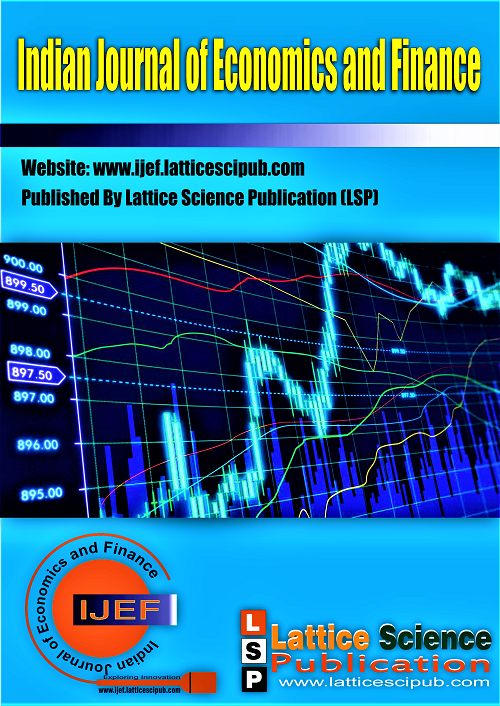Exploring Wagner's Law in India: An Empirical Study of Economic Growth and Public Expenditure
Main Article Content
Abstract
In this research paper, we test the connections between public spending and economic growth in India by employing annual data from 1981-82 till 2019-20. We examine if there is a long-run relation between public spending and economic growth and then we try to understand the direction of causality between them by using six versions of Wagner's law along with an augmented version. The paper employs tests of stationarity, cointegration, granger causality and the vector error correction model for the analysis in all the versions. Results from these tests show that only some versions give support to validateWagners' law in India over the sample period studied.
Downloads
Article Details

This work is licensed under a Creative Commons Attribution-NonCommercial-NoDerivatives 4.0 International License.
How to Cite
References
Afzal, M., & Abbas, Q. (2010). Wagner's law in Pakistan: Another look. Journal of Economics and International Finance, 2(1), 12.
Ahuja, D., & Pandit, D. (2020). Public Expenditure and Economic Growth: Evidence from the Developing Countries. FIIB Business Review, 9(3), 228-236. https://doi.org/10.1177/2319714520938901
Alimi, S. R. (2013). Testing Augmented Wagner's Law for Nigeria Based on Cointegration and Error-Correction Modelling Techniques. MPRA Paper No. 52319. Online at https://mpra.ub.uni-muenchen.de/52319/
Budhedeo, S. H. (2018). Cointegration, Causality, and Wagner’s Law: An Econometric Analysis for India. Research Journal of Humanities and Social Sciences, 9(4), 785-792.
doi: 10.5958/2321-5828.2018.00132.8 https://doi.org/10.5958/2321-5828.2018.00132.8
Enders, W. (2004). Applied Econometric Time Series (2nd ed.). Wiley Series in Probability and Statistics.
Gangal, V. L. N., & Gupta, H. (2013). Public Expenditure and Economic Growth: A Case Study of India. Global Journal of Management and Business Studies, 3(2), 191-196. Retrieved from http://www.ripublication.com/gjmbs.htm
Goffman, I. J. (1968). On the Empirical Testing of Wagner’s Law: A Technical Note. Public Finance, 23, 359–364.
Gujarati, D. N., & Porter, D. C. (2010). Essentials of Econometrics (4th ed.). Boston, MA.
Gupta, S. (1967). Public Expenditure and Economic Growth: A Time Series Analysis. Public Finance, 22, 423–461.
Halicioĝlu, F. (2003). Testing Wagner's law for Turkey, 1960-2000. Review of Middle East Economics and Finance, 1(2), 129-140. https://doi.org/10.2202/1475-3693.1007
Iyare, S. O., & Lorde, T. (2004). Co-integration, causality and Wagner's law: tests for selected Caribbean countries. Applied Economics Letters, 11(13), 815-825. https://doi.org/10.1080/1350485042000254881
Javed, A., & Khan, W. A. (2021). Wagner’s Hypothesis in India: An Empirical Investigation Using Bivariate Framework. Webology, 18(6). http://www.webology.org
Johansen, S., & Juselius, K. (1990). Maximum likelihood estimation and inference on cointegration--with applications to the demand for money. Oxford Bulletin of Economics and Statistics, 52(2), 169-210. https://doi.org/10.1111/j.1468-0084.1990.mp52002003.x
Kesavahraja, M. (2012). Wagner's Law in Sri Lanka: An Econometric Analysis. International Scholarly Research Network, 2012, Article DI 573826, 9 pages. doi: 10.5402/2012/57382 https://doi.org/10.5402/2012/573826
Magazzino, C. (2012). Wagner’s Law and Augmented Wagner’s Law in EU-27. A Time-Series Analysis on Stationarity, Cointegration and Causality, International Research Journal of Finance and Economics, 89, 205-220.
Mann, A. J. (1980). Wagner’s Law: An Econometric Test for Mexico, 1925-1976. National Tax Journal, 33, 189–201. https://doi.org/10.1086/NTJ41862301
Medhi, K. (2014). An Empirical Investigation of the Causality between Government Expenditure and Economic Growth in India during 1974-2010. IOSR Journal of Humanities and Social Science, 19(7), 53-58. https://doi.org/10.9790/0837-19745358
Murthy, N R Vasudeva. (1994). Wagner's Law , Spurious in Mexico or Misspecification: A Reply. Public Finance = Finances publiques, vol. 49(2), pages 295-303.
Murthy, N. R. Vasudeva (1993). Further Evidence of Wagner's Law for Mexico: An Application of Cointegration Analysis. Public Finance = Finances publiques, vol. 48(1), 92-96.
Musgrave, R.A. (1969), Fiscal Systems, New Haven and London: Yale University Press.
Najarzadeh, R., & Khorasani, E. (2019). A Review of Wagner's Law and Income Elasticity of the Government Expenditures in Iran (1985-2018). RAIS Conference Proceedings - The 14th International RAIS Conference on Social Sciences and Humanities. https://doi.org/10.2139/ssrn.3459581
Narayan, P. K., Nielsen, I., & Smyth, R. (2008). Panel data, cointegration, causality and Wagner's law: Empirical evidence from Chinese provinces. China Economic Review, 19(2), 297-307. https://doi.org/10.1016/j.chieco.2006.11.004
Narayan, S., Rath, B. N., & Narayan, P. K. (2012). Evidence of Wagner's Law from Indian States. Economic Modelling, 29(5), 1548-1557. DOI: 10.1016/j.econmod.2012.05.004 https://doi.org/10.1016/j.econmod.2012.05.004
Ogbonna, B. C. (2015). Testing for Wagner's Law on Greek Economy. International Journal of Development and Economic Sustainability, 3(5), 26-35. Available at: https://www.researchgate.net/publication/307882725
Peacock, A. T., & Wiseman, J. (1961). The growth of public expenditure in the United Kingdom,Princeton University press.
Pryor, F. L. (1969). Public Expenditures in Communist and Capitalist Nations. George Allen & Unwin.
Sharma, D. V., & Sundaram, R. (2021) Wagner’s Law: An Empirical Analysis with Reference to India. 13th international conference on modern research in management, economics and accounting, 05-07 November 2021, Amsterdam.
Sharma, S., & Singh, S. (2019). The Validity of Wagner’s Law in India: A Post-liberalization Analysis. South Asian Journal of Social Studies and Economics, 4(2), 1-13. https://doi.org/10.9734/sajsse/2019/v4i230124
Srinivasan, P. (2013). Causality between Public Expenditure and Economic Growth: The Indian Case. International Journal of Economics and Management, 7, 335–347. https://doi.org/10.2478/revecp-2020-0020
Tesařová, Žaneta (2020). Wagner's law testing in the Visegrád Four countries. Review of Economic Perspectives, 20(4), 409-430. https://doi.org/10.2478/revecp-2020-0020.
Modi, A., & Kesarani, V. (2023). Digital Lending Laws in India and Beyond: Scrutinizing the Regulatory Blind Spot. In Indian Journal of Economics and Finance (Vol. 3, Issue 1, pp. 1–7). https://doi.org/10.54105/ijef.a2542.053123
D, R., & D, Dr. J. (2019). An Examination on Adequacy of Law in India to Regulate and Monitor Media. In International Journal of Engineering and Advanced Technology (Vol. 8, Issue 6s3, pp. 1493–1496). https://doi.org/10.35940/ijeat.f1265.0986s319
Forms of Modern Lawmaking in the System of a Theoretical and Applied Paradigm of Law Knowledge. (2019). In International Journal of Recent Technology and Engineering (Vol. 8, Issue 4S, pp. 78–82). https://doi.org/10.35940/ijrte.d1026.1184s19





